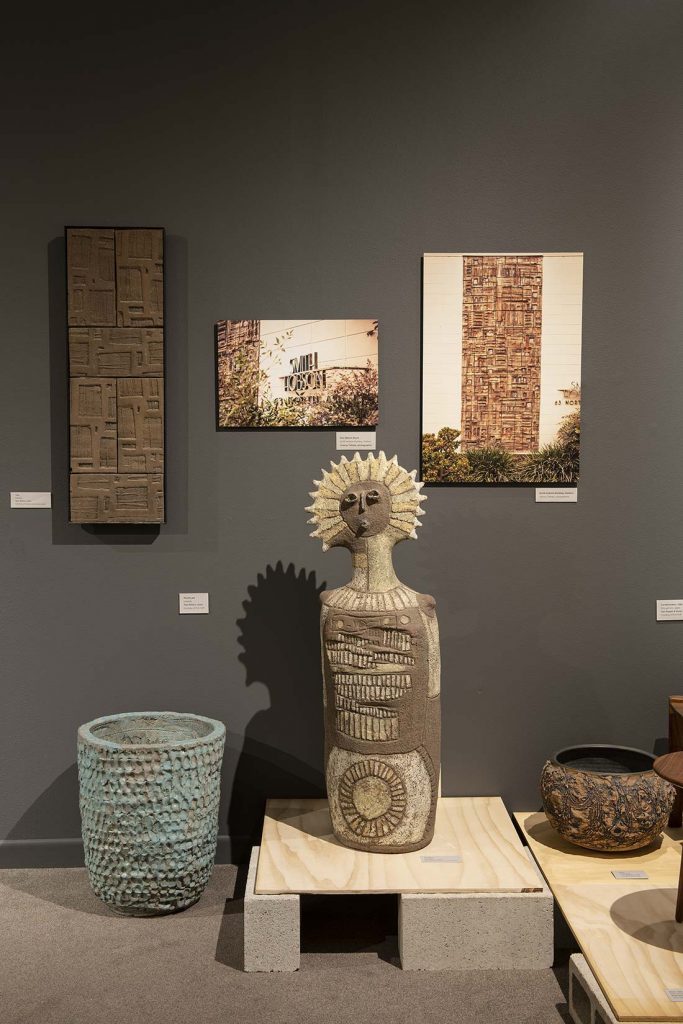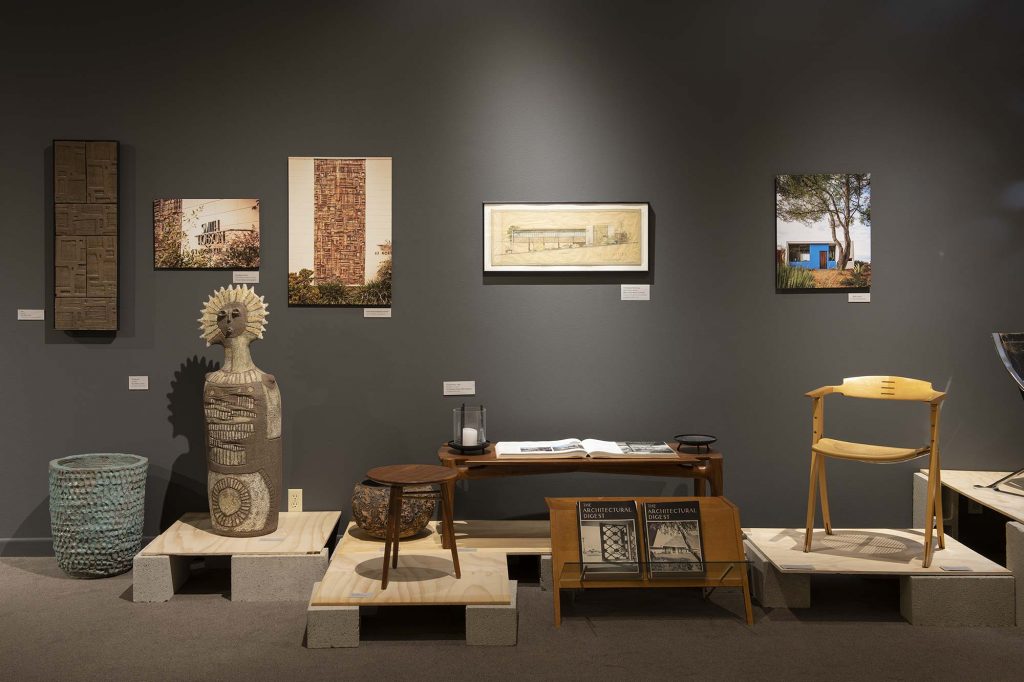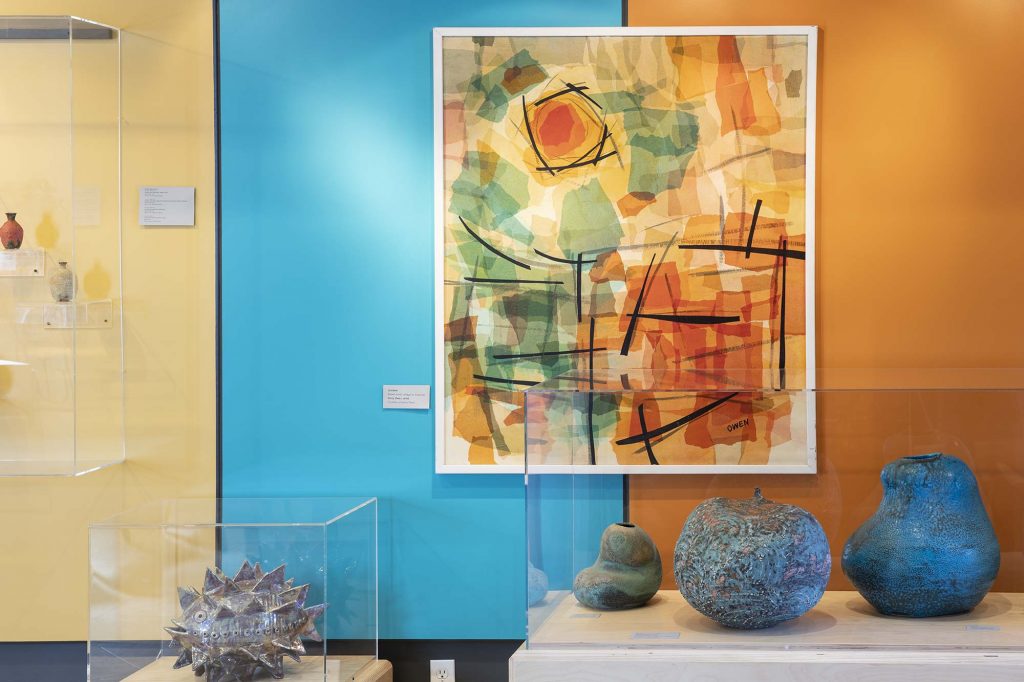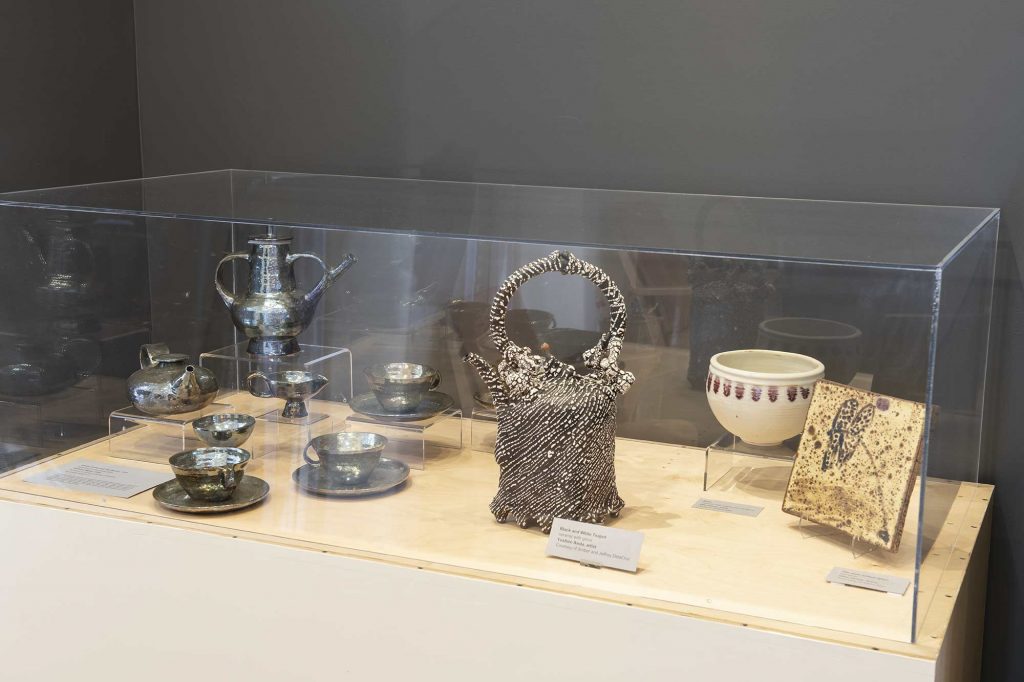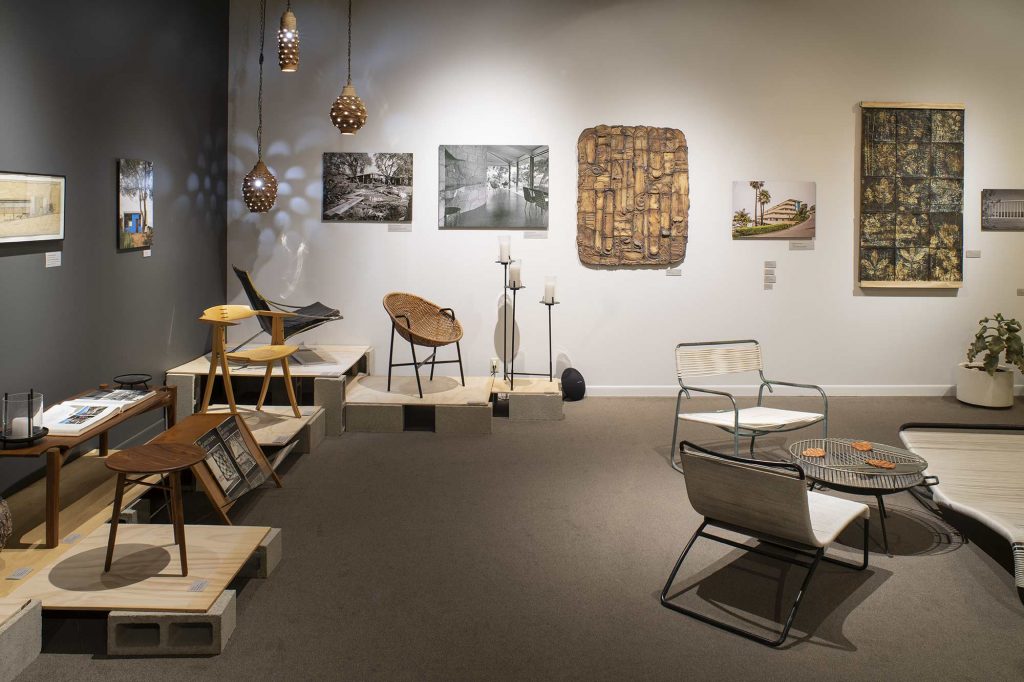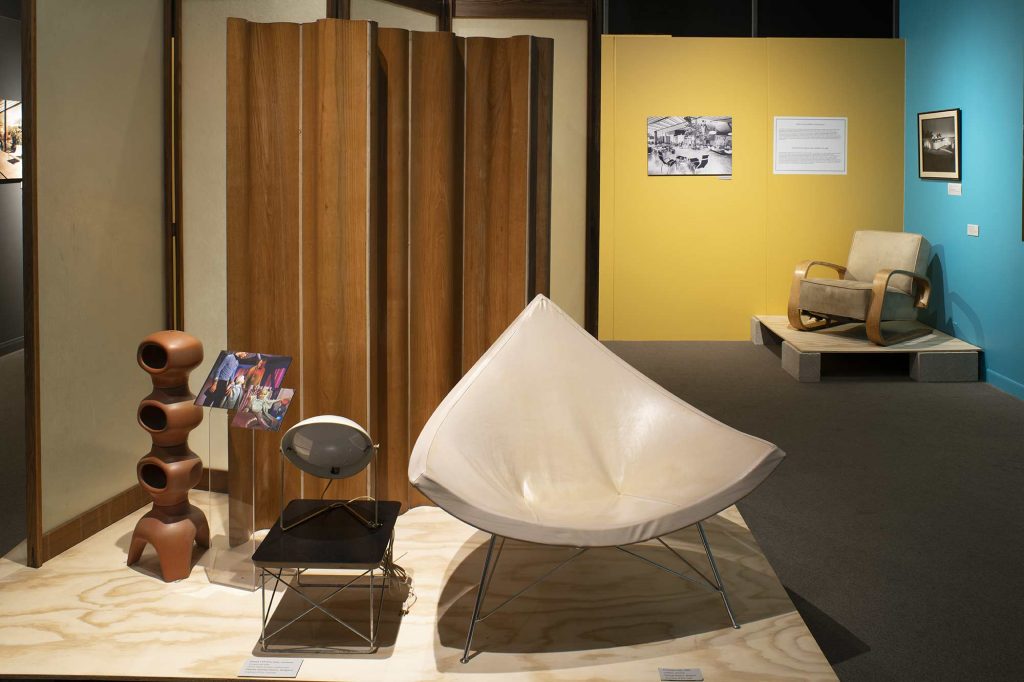The Central Coast of California offered an obvious appeal to followers of modernism. The extensive access to the coast and higher elevations afforded by the region’s many beaches and foothills, and the mild Mediterranean climate served as a central reason for indoor-outdoor living. But the Central Coast offered more than a geography and climate. The different regions of the Central Coast offered other unique appeals.
The Ojai Valley served as an early staging ground for the region’s movement, particularly in terms of Jiddu Krishnamurti’s decision to establish his home and Star Publishing Trust in Ojai, where the search for spiritual enlightenment was sometimes accompanied by patronage of the arts.
This created important opportunities for pioneering artists and craftspeople who would call the Ojai Valley home. Beatrice Wood settled in Ojai in 1947, seeking to establish herself near to Krishnamurti. Eventually, potters, Otto and Vivika Heino, purchased a house from Wood, using their new space to maintain a highly successful pottery business.
Local institutions proved equally important to the region’s modernist movement. The University of California, Santa Barbara, offered a central point for employment, attracting important talent of the period.
Michael Arntz taught at the university for years, inspiring new generations of artists and craftspeople. Oscar Bucher’s founding of the ceramic and glassblowing programs at Santa Barbara City College extended the region’s Arts and Crafts aesthetic even further. Panelcarve, a company founded by architect and later Montecito resident Sherrill Broudy that specialized in the production of architectural carved redwood panels and reliefs designed by Broudy and Evelyn Ackerman, eventually became Forms+Surfaces, a company that expanded to include the fabrication of bonded metal doors and furniture.
Fiberglass, the pioneering use of which shaped dual-hulled sailing vessels, kayaks, and the regions blossoming surfing culture, made way for Architectural Fiberglass, a division of Architectural Pottery based out of Oxnard.
Gallery Photographs by Scott Miles
This photo features the work of Stan Bitters and Tom McMillin
Stan Bitters’ career in ceramics has spanned six decades. Studying at UCLA and Otis College of Art and Design, he was largely influenced by ceramist Peter Voulkos. His large-scale works include ceramic wall murals, sculptures, fountains and garden pathways.
Bitter work in this photo includes, from left to right: “Bricks” a ceramic wall mounted piece on loan to the museum from Steven and Deirdre Bolm, “Thumb Pot” a ceramic piece on loan from Eric Huff, and “Sun Maid” a ceramic sculpture also on loan from Steven and Deirdre Bolm. On the wall, you can see photos of Stan Bitters’ larger ceramic mural created for the front of the Smith Hobson Building on Ash Street in Ventura. Photos are courtesy of Tommy Tatham.
This photo also includes a round ceramic vessel by local artist, Tom McMillin on the far right, lower platform.
Tom McMillin is a sea captain, ceramist and installation artist. He cites a profound impact on his art from growing up on a farm and becoming the youngest licensed Coast Guard Captain on the West Coast at age 18. He attributes his father with giving him a “great appreciation of the soil” and a mentor captain with “a great respect for the sea.”
After graduating from USC with an MFA in ceramics, McMillin set up a studio and made a living as a full-time artist.
Tom says, “My art has been devoted to process and environmental concerns. My installations have dealt with laminar flow, sedimentation, erosion magnetic fields and various other natural phenomena. My goal is to point out the intrinsic beauty within these natural systems.”
Classic Mid-Century Modern Designs
This photos shows various pieces of mid-century modern furniture along with the previously mentioned art pieces. There are some wonderful examples here of classic mid-century modern designs.
First we have a stool created in 1955 for Glen of California by Kipp Stewart.
Stewart was trained as an architect but really distinguished himself as a furniture designer. Influenced by the late Charles Eames whom he worked with during his career, Steward focused on simple, functional elegance.
Bud Tullis coffee table
Bud Tullis grew up in Long Beach. Bud began his college life in Salt Lake City, Utah, studying architecture. After dropping out he worked in the family welding supply business which brought him to Seal Beach, California. After receiving a Masters in Fine Art from Long Beach State, he apprenticed with the Bolinas Craft Guild where he began a 38 year career in woodworking out of his shop in the Santa Ynez Valley. Partnering with Paul Tuttle in 1982, Tullis’ designs are sleek and functional, combining materials such as metals and wood.
Hurricane Lamp, Stan Hawk (on top of coffee table)
Stan Hawk’s company, Hawk House designed lamps, and iconic three-legged braziers or barbecues and outdoor decor, bringing mid-century modern living to your backyard.
Paul Tuttle chair and magazine rack
Fusing metal and wood, Tuttle’s magazine rack and chair again show his love of simple elegance in his designs.
Rendering of the Smith Hobson building by Wilson, Stroh, Wilson, architects out of Santa Paula
The architectural firm of Wilson Stroh Wilson in Santa Paula was one of the most prolific architectural firms in Ventura County. Started by Roy C. Wilson, an architectural student who never finished his education, along with fellow architect, John Stroh and later followed by his son, George Wilson, the firm designed many well-known buildings in the area including numerous schools, hospitals, packing houses and churches.
Their mid-century modern style was well-known but not always well-received as more traditional and conventional styles were more in keeping with the small town feel in this predominantly agricultural county.
Beatrice Wood and the work of ceramist, Yoshiro Ikeda ceramics
First of all, let’s talk about the background art that we see throughout the exhibit.
Usually art exhibits need no background as the art speaks for itself. However, in this exhibit, the furniture pieces, while each in their own way a work of art, needed a little something to enhance them and really bring them to life.
Here’s where the art of former Ventura High School art teacher, Perry Owen comes in to play. The art sort of fell into our laps, so to speak. Daughter Jenny Owen called the Exhibits Department to ask if our exhibits team might be interested in the work of her father, Perry. She explained that much of the work was beach scenes and harbor scenes. Not really needing anymore landscape art for the collection, we made the decision to meet her anyway to see her father’s pieces. The art was much as I expected: beautifully executed but not really something we were interested in collecting. But what caught my eye was the work in the back of the storage unit. Abstracts from an earlier time in Perry Owen’s career. Beautiful, colorful and bold. I knew they would be perfect to exhibit along with the mid-century modern furniture as they had that same vibe!
When the paintings were brought into the gallery as collectors were dropping off their loaned pieces, there was a general enthusiasm and excitement to see these abstracts and all felt that they were perfect for the exhibit. Several visitors and one collector knew Mr. Owen or had him as an art teacher at Ventura High School which made it a truly personal experience.
We thank Jenny Owen for the loan of her father’s work.
Beatrice Wood, Fish with Lustre Glaze, mid 1960’s from the Museum of Ventura County Collection
Created by Ojai artist Beatrice Wood, known as “The Mama of Dada” this blowfish is created in the mid century modern style with angular points and simple design. Wood began working in ceramics in 1933 when she took a class at Hollywood High School. When Wood could not find a teapot to match a set of antique luster plates she had bought, she decided to make her own. In the 1950’s the emergence of abstract expressionism led her to coat the entire body of her ceramic works with shimmering lusters! This style became her trademark and she is recognized as one of the pioneers of experimenting with luster glazes. Beatrice Wood died in 1998 at the age of 105, with the last 25 years of her life being the most productive. She created work to satisfy the growing market for her ceramics, writing books, and visiting with the hundreds of people who showed up on her doorstep.
Ikeda spent part of his career living and working in Santa Barbara and teaching at Santa Barbara City College and Ventura College. Possibly the most recognizable feature of his art the surface treatment of his pieces. His multiple glaze applications and multiple electric kiln firings resulted in richly textured exterior surfaces.
Yoshiro Ikeda was internationally recognized for his ceramic art. Ikeda first studied architecture but when he had to take art classes toward his major he realized that he had found his real calling. This was a real disappointment for his hardworking parents who wanted him to find a career where he could actually make money. Nevertheless, he continued to pursue ceramic art and we are so very glad he did!
Ceramic Vessels, Yoshiro Ikeda From the Collection of Eric Huff and the Museum of Ventura County
Case with Beatrice Wood Coffee and Tea service, Yoshiro Ikeda Teapot, and Otto Heino Bowl and tile.
Here we have a lusterware coffee and tea set by Beatrice Wood that is part of the Museum of Ventura County’s collection. What’s the difference between a coffee and tea set? First of all the pots. You can see in this set, the coffee pot is the larger of the two. Its quite tall and slender. The teapot is shorter and rounder. Usually there are two different cups for coffee and tea with the teacups being much smaller. In this set, you can notice that the coffee/tea cups are quite large and very contemporary. Note the mid-century modern look of the sugar and creamer.
This teapot by Yoshiro Ikeda was on loan to the museum from Amber and Jeffrey DelaCruz. The teapot belonged to Amber’s grandmother. You can see the beautiful, complex glaze surfaces that have built up due to multiple firings.
The two other pieces in the case belong to museum docent, Mimi Allen. They are both by the renowned ceramist, Otto Heino who lived and worked in Ojai. Otto was one half of a team made up of himself and his wife, Vivika, also a ceramist. They followed the work of European masters such as Gertrud and Otto Natzler. They were both always willing to provide instruction about their craft. Their dedication to functional ceramics is well-known.
During his lifetime, Otto set out to find the formula for an ancient Chinese yellow glaze. Finally, after a decade of trial and error, he rediscovered the formula. The two pieces in this case were made using that yellow glaze.
History Gallery at the Museum
This is a great shot of the future History Gallery at the Museum which was the final room of the California Cool exhibit. You can see the Kipp Stewart, Bud Tullis, and Paul Tuttle pieces previously mentioned.
We also have a view of the beautiful beehive hanging lamps created by ceramist Tom McMillin. These were graciously loaned to us by Forrest Merrill of Berkeley.
In the corner you can see the metal and leather Z Chair designed by Paul Tuttle in 1965 for Carson-Johnson and Dan Johnson’s rattan and steel basketweave chair designed in 1951 on loan to us from one of our guest curators, Steve Aldana.
You’ll also notice a three-tiered glass and iron candle holder by Stan Hawk.
Along the wall you have another piece by Tom McMillin: a ceramic stoneware panel. The darker ceramic panel is by Otto Heino. Both were on loan to the museum by Forrest Merrill.
In front of these pieces you have a barbecue scene right out of someone’s backyard with a three-legged brazier, or grill, by Stan Hawk complete with steaks, and those famous rope chairs and chaise.
The chairs are both different in design and designer. The chaise and rope chair were designed by Kipp Stewart for VKG. The wider rope chair with the open back was designed by Walter Lamb.
In the far corner you can see a white pot with plant. This was a design by a company that had a tie to Oxnard. This company was Architectural Pottery, started by Max Lawrence. The company created clean, cylindrical vessels, devoid of any ornamentation and used not only for private homes but for many businesses in and around the Los Angeles area, including many of the outdoor malls that were becoming quite popular during the 1960’s.
Architectural Pottery eventually made way for Architectural Fiberglass based in Oxnard, that created planters, pots and more out of fiberglass.
Eames folding screen, Coconut Chair, Tank Chair
It was decided early on in the exhibit-making process to add some color to the galleries in the form of focal walls. Lately the MVC galleries have been painted a neutral gray called “Knights Armor.” It seems to work with most exhibits and makes most objects “pop” when mounted, but it didn’t exactly speak to the Mid-Century Modern vibe we were going for. It was decided to add some colors reminiscent of the era: avocado green, turquoise blue, yellow/ochre (not Harvest Gold), and burnt orange. As you can see in the photos, the pops of color worked!
This photo has several interesting pieces. We start with the Eames folding screen, belonging to collector, Eric Huff. I want to add that Eric also served as a guest curator for this exhibit and we thank him for his many generous donations of objects, research resources and building materials.
The Eames folding screen, designed in 1946, was made of birch plywood and canvas and designed by husband and wife team, Charles and Ray Eames for the Herman Miller Company. The Eames noted that u-shaped cross sections of plywood from their early molding experiments were stable enough to stand alone. To make the screen, they joined sections of plywood to canvas hinges with an adhesive developed during World War II. The screen was made in six, eight, and ten-panel versions with several different finishes to choose from. The canvas straps allowed it to be folded upon itself to a compact size when not in use.
Introduced by Herman Miller in 1955, the Nelson Coconut Chair, designed by George Nelson, changed American furniture as it offered supreme comfort and freedom of movement. Shaped to look like a piece of coconut, the chair is designed to let you sit in any position and move with ease.
One of the milestones of furniture design, was the Armchair 400 designed by Finnish architect, Alvar Aalto. Also known as the “Tank Chair,” it was designed in 1936 for the Milan Trienniale. With a sturdy seat and wide armrests, this chair offers a comfortable seating experience, despite the tank-like appearance. This particular chair was used in designer Rodney Walker’s home.
In the corner of the photograph we have a floor lantern designed by Malcolm Leland for Architectural Pottery. The lantern contains a base, two center modules, and a top module. Those modules were made to turn in any direction the user chose. The space age design of the lantern made it a perfect prop to use in Star Trek, episode 10, season 1, called The Corbomite Maneuver, starring a very young Clint Howard.

